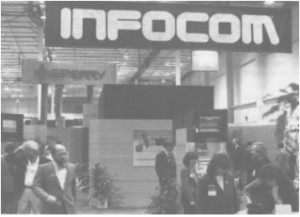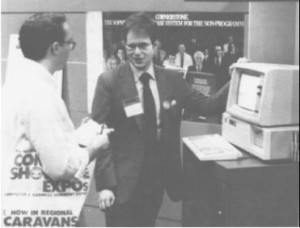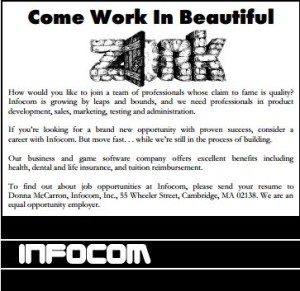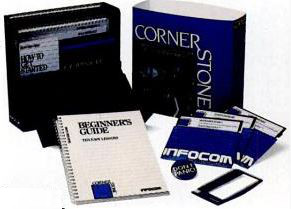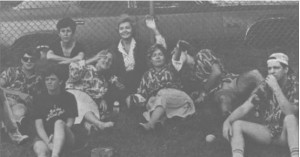Infocom entered 1985 filled with ebullient optimism. They had just released their fastest-selling game ever, The Hitchhiker’s Guide to the Galaxy; hosted two splashy Manhattan press conferences, just like the big boys, the first to announce Hitchhiker’s and the second to announce their debut business product, the Cornerstone database; signed a lease to leave the cramped environs of their offices on Wheeler Street and take over an entire floor of a modern, stylish office complex on CambridgePark Drive that had an atrium for God’s sake. That January’s Consumer Electronics Show saw Infocom put out the most lavish (and expensive) trade-show effort they would ever tackle, including a big show-floor display for the games as well as the soon-to-be-released Cornerstone and a memorable murder-mystery party with a cast of thousands to promote their latest game, Dave Lebling’s Suspect.
It was a heady time indeed. Infocom, who had been successful at everything they’d attempted thus far, were going to continue to pioneer a whole new form of interactive literature at the same time that they became the next Lotus-style sensation in business software. They were a smart bunch of people, and every decision they’d made so far had proved to be the correct one. Why should that change now?
Well, it was about to change in a hurry. By year’s end Infocom would be a shell of the company it had been less than twelve months before, in financial free fall and willing to give up all of their higher hopes of January in return for simple survival. It was, to say the least, a humbling experience, as suddenly this bunch who had never known failure seemed to experience little but. To understand that crazy year, understand how Infocom got from here to there, we have to step back again to 1984. Having already told the story of Infocom the Interactive-Fiction Pioneer in 1984, it’s time to tell the shadow history of Infocom the Would-Be Business-Software Company.
I’ve described already in an earlier article how Cornerstone — known until quite late in the game as the InfoBase — was first proposed by Brian Berkowitz and Richard Ilson, a pair of programmers the Imps knew well from MIT’s Artificial Intelligence Lab, when Infocom was enjoying the first rush of popular success that followed the Zork games and Deadline. I also told how the InfoBase graduated from research project to major strategic initiative during 1983. In January of 1984 Al Vezza took the title of CEO from Joel Berez, and started planning how to spend the $2 million loan he had just secured from the Bank of Boston to make the InfoBase, still just a bunch of ideas and code and prototypes, a real commercial product.
Vezza was determined to get only the best for his pet project. In March, he hired as head of Business Products John Brackett, yet another MIT alum who had already spent more than twenty years working in the computer industry. Brackett had a technical and, if you like, a philosophical background that seemed perfect for Infocom. His previous company SofTech had been, along with Apple, a licensee of the University of California San Diego’s Pascal-driven P-Machine, inspiration for Infocom’s own Z-Machine. SofTech and Brackett had done good business for several years selling and supporting the P-Machine to application developers, until the arrival of the IBM PC established MS-DOS as the standard for business computing and made cross-platform portability, at least for the time being, less of a priority there.
The InfoBase itself was being built using an expanded version of Infocom’s core Z-Machine technology. Like the game developers, InfoBase developers did their coding and initial testing on the company’s big DECSystem-20 minicomputer. Only occasionally would the code be moved to microcomputers for testing on the new interpreters that were also being developed. When it became clear that the DEC was getting overtaxed by so many users, Vezza signed a lease to bring in a complete new DECSystem-20 in May for the exclusive use of Business Products, a commitment of hundreds of thousands of dollars. Meanwhile he and Brackett kept hiring; soon Business Products people outnumbered Consumer Products (i.e., games) people, and the inevitable resentments started to fester in earnest.
The games people — even those who actively opposed or just weren’t much interested in the InfoBase itself — had few or no problems with the technical people who worked in Business Products. Those folks were largely in the mold of Berkowitz and Ilson, a couple of MIT hackers with much the same values and working habits as the Imps themselves; if things had gone slightly differently, people like Marc Blank and Dave Lebling must have realized, they could have been writing the database while the database people wrote the games. Both projects were, at their core, just Interesting Coding Projects, every hacker’s lifeblood. No, it was the suits who started to arrive en masse as the InfoBase got closer to release who really stirred up ire. Included in this group were the office managers and the HR directors and the financial planners and no fewer than fourteen well-scrubbed business-marketing experts. “They weren’t even on the same planet,” said Tim Anderson later. “These guys were showing up at work at nine in suits.” Steve Meretzky became a ringleader of an ongoing subversion of Vezza and Brackett’s attempts to transform Infocom into just another buttoned-down corporation like their role models and everyone’s favorite business-software success story, Lotus. “Memo hacking” was one of his favorite strategies.
A certain HR manager, hired from DEC, arrived with a binder full of “memo templates” to be used for all intra-office communication. She loved memos so much that people were soon just calling her “Memos.” When she sent out a memo instructing everyone on the proper care of their office plants, Meretzky decided enough was enough. He and a few co-conspirators surreptitiously replaced the original memo in everyone’s in-box with another, which said that the company was now offering a service to take care of employees’ house plants; it seemed there was concern in management that, what with the long hours everyone was working, said plants were being neglected. An included multi-page questionnaire asked for the location of each plant as well as such essential information as the song it preferred to have sung to it while being watered. Some people took it seriously, mostly — and much to Meretzky and company’s delight — the poor humorless souls in business marketing and the other more buttoned-down wings of the company. HR rushed around to put a cover sheet on each memo saying it was not to be taken seriously, whereupon Meretzky and company added a cover sheet of their own saying the cover sheet saying not to take the memo seriously should itself not be taken seriously. “Immense confusion” followed.
Not learning her lesson, Memos was soon distributing a “Flowers and Fruit Basket Request Form,” for sending out condolences to employees’ families who were experiencing a bereavement. Meretzky did her one better, creating a “Flowers and Fruit Basket Request Form Form”; the idea would later show up in Stationfall as the “Request for Stellar Patrol Issue Regulations Black Form Binders Request Form Form.”
While Memos took her lumps, Public Enemy #1 for much of Consumer Products was Al Vezza himself. The humor at Infocom was always irreverent but almost never cruel or crude. That related to Vezza, however, was often an exception; some of the more popular Vezza epithets, which we shan’t get into here, were both. One former employee, normally a model of good temper and equanimity, still says of Vezza today, “There are very few people in my life that I’ve really disliked — and Al is definitely one of them.”
I find with most who engender such negativity that, while it’s hard to argue that it’s not their fault, there’s also something a bit sad about the person in question. Vezza’s professional character was defined by a number of toxic combinations. He was a thoroughly conventional thinker, of the sort who sourced all of his wisdom from business self-help books, yet nevertheless believed himself to be a bold innovator. He was arrogant and dismissive of opinions of others, particularly of those younger than him, yet also deeply insecure. At risk of playing pop psychologist, I’ll posit that some of his attitudes may stem from his experience at the MIT AI Lab. Despite having no advanced degree himself, he had parlayed a role as essentially J.C.R. Licklider’s administrative assistant into one of considerable power and influence, even serving as an undergraduate thesis adviser. Perhaps he learned there that he had to in some sense fake surety and authority despite continuing to feel intimidated by his often brilliant charges. His insecurity manifested itself in a tendency to micromanage that drove everyone around him crazy, while the lack of faith in his people that it implied destroyed morale and created storms of negative feelings. For Vezza the business was all too personal. Infocom was “his” company, first proposed and organized by him, his way to make his mark on the world. He seemed to regard the games and the company’s current reputation, which had been built with little input from him, as a sort of hijacking of something rightfully his. Now he was determined to reclaim his original vision for Infocom.
He also seemed determined that his means to that end should be the original company he had founded in 1979, and under its original name. The Board had held serious debates already during the spring and summer of 1983 about whether it made sense to create both games and business applications under the Infocom banner. In one of his rare Board meeting appearances, even Licklider offered support for making the budding Business Products division a company unto itself. That way, “employees might feel they’re contributing to their own company rather than engaged in rivalry with the other division.” Marc Blank was still more ominously prescient: he was “afraid that [Business Products] division might sink the company unless it’s made more separate.” Vezza, however, was resistant, and the Board seemed reluctant to directly challenge him on this as on many other subjects.
Immediately after Vezza’s ascendancy, Mike Dornbrook paid him a visit in his office to try again:
“Al, I really think it’s a mistake to have this product and the games business all under one umbrella,” I said. “I would honestly not put that out as Infocom. I think Infocom now means adventure games, and it will confuse the people who are buying adventure games as to what we’re all about. And I think it will actually be a detriment to any business product, that it’s coming from a games company.
“You can have the same shareholders. Just divide the company into two entities. We can share the building. We can share computers. But have two separate legal entities, and raise money for the business entity separately, and keep the [Business Products] books separately from the gaming business.”
His response to me was, “You don’t understand finance.” So I walked out of the room thinking, oh well, I tried.
Weeks later, with Brackett installed as head of Business Products and a whole associated bureaucracy falling into place, it would be too late to change course even had Vezza had a change of heart. The decision to do the InfoBase under the Infocom banner would prove to be perhaps the worst of many unwise choices made during Vezza’s reign. Dave Lebling describes the problems that resulted:
When they [Vezza and the Board] went out to look for capital to build [the InfoBase] into a real product or to continue to build the games into an even “realer” product or to move them forward, what they found was that investors who were interested in the business product would look at the other part of the ledger sheet and say, “Why are these games here? What is this about? Are you guys insane?” And the people who were looking at the games part would say, “Oh, wow! Cool ideas! You guys got a great business going here. But what is this stupid business thing?”
In retrospect, with that wonderful 20/20 hindsight we all have, it would have been better to have two companies.
Due to the issues Lebling describes as well as a general closing of the financial spigots in a maturing industry, Vezza and company found venture capitalists much less positively disposed to give Infocom their money than they had anticipated. In the end they would manage to secure only $500,000 in free-and-clear capital, from the state-run Massachusetts Capital Resource Company. Despite the Board’s having given lip service to maintaining at least a modicum of a financial firewall between Business Products and Consumer Products, the former ended up sucking up virtually all of the profits of the latter, leaving precious little funding for a whole range of projects that Blank and Berez felt were essential for Infocom to maintain their position as leading lights in games. Projects to expand the size and complexity of the stories they could tell; to dramatically improve their already industry-leading parser; to build a cross-platform graphics system that would let them add pictures to their games; to experiment with multi-player networked interactive fiction; to expand into entirely new genres beyond adventure gaming — all were starved for funds, forced to be dramatically scaled back or cancelled entirely. Seeing this essential work go so neglected, Berez and particularly Blank argued with the other, business-centric members of the Board with less and less civility, all but paralyzing the company as a whole at times. The newest Board member, Ray Stata, threw his hands up in despair at the June 6, 1984 meeting: “I won’t be polite anymore — company management is terrible!”
When there was no more money lying around for them in Consumer Products, the ever-expanding Business Products division — full-time employees at Infocom would peak at 110 by June of 1985, up from 20 two years before — began financing itself through a series of loans, putting the whole company under a cloud of increasingly dangerous financial obligations and further raising the ire of Berez and Blank.
The InfoBase, now called Cornerstone, shipped at last on January 31, 1985, at a suggested retail price of $500. For all the culture clashes it had engendered, there was more than a little of the Infocom game DNA in its presentation and packaging as well as the DEC-authored, Z-Machine-derived software on the disks themselves. Infocom, with the aid of the invaluable folks at G/R Copy, was really good at putting their best foot forward in presenting their products, and Cornerstone was no exception; just the name alone was a great, classy choice. The packaging was an elaborate affair, a glossy slipcover over a solid plastic box that popped open accordion-style to reveal no fewer than three spiral-bound, 200-plus-page manuals. There was even a feelie, a “Don’t Panic!” button that varied only in color from the one found in the Hitchhiker’s package.
Having never seriously used a relational database in my life, I’m eminently unqualified to offer a thorough review of Cornerstone from personal experience here. However, I feel confident in saying based on my dabblings and the reviews it received in the contemporary press that it’s a somewhat peculiar mixture of the innovative and the misguided. Cornerstone’s mantra, claim to fame, and primary selling point was to be “the database system for the non-programmer.” This rhetoric was quite clearly directed against the leading PC database of the era, Ashton-Tate’s dBase III, an application so quirky and fiddly that it can come off almost like a satire of user-hostile DOS-era application software. Doing virtually anything with dBase III required learning its esoteric, proprietary command language, a process as complicated as that of learning to program in any other language. While it had been in development just a bit too long to embrace the new paradigm of the full-fledged mouse-driven GUI, Cornerstone nevertheless strained to be a friendlier experience than dBase III, with features like automatic command completion, extensive in-program help, menus, even a system of what would later come to be called “Wizards” to walk users through common tasks via prompts and questions.
A certain sort of user fell in love with Cornerstone, in some cases continuing to use it for years after it went out of print. Marc Blank has told of going to his dentist well after his tenure with Infocom finished and realizing that the receptionist was using it to take down his billing information. Andrew Kaluzniacki, who worked in Infocom’s Micro Group during Cornerstone’s development, noticed four years after leaving that his aunt, a veterinarian, was running it in her office. She said “she loved it. It was easy and she was able to do the database work herself without ever really knowing she was using a database.”
Yet for other sorts of users Cornerstone had at least two huge failings. The first was a byproduct of Infocom’s decision to make it an interpreted product, running through a Z-Machine-like interpreter, rather than writing native code. It was a decision that had made a certain amount of sense back when the project had first been conceived in 1982, when the business-computing market was still comparatively wide open, a mixture of CP/M machines and the new IBM PCs and even still a fair number of Apple IIs, Radio Shack TRS-80s, and Commodore PETs. By 1985, however, that had all changed; much as Apple might have liked to see the young Macintosh as a viable challenger, the business market was owned by IBM PCs and clones running MS-DOS. Anyone serious enough about a database to be willing to spend $500 on it was virtually guaranteed to have this setup. On these machines, especially the many lower-end models still using the original 4.77 MHz 8088 CPU, Cornerstone ran noticeably slowly in comparison to the competition. Sometimes more than noticeably: a PC Magazine reviewer simply gave up trying to run their longest benchmark test when their next-to-longest took 3.5 hours to complete. John Brackett had left his previous company SofTech precisely because demand for their own portable P-Machine system had flagged due to the IBM PC’s adoption as the universal business standard. That no one at Infocom, including Brackett himself, made the obvious connection here almost beggars belief. The DECSystem-20 and virtual machines seemed to be so ingrained in Infocom’s culture that no one could imagine an alternative. In the end Cornerstone was never released for a single platform other than the IBM PC. All that money spent on the DEC, all that programming time and energy sunk into designing the virtual machine and writing its interpreters, all that speed lost in the final product — all were for naught. Cornerstone wasn’t poorly designed on a technical level; most everyone involved with Infocom agrees that it was technically rather brilliant. But much of that brilliance was unnecessary, costly brilliance.
Cornerstone’s other crippling flaw was, ironically given its tagline, its lack of programmability. Ease of use is a wonderful thing, but there comes a time when you need to just write a script to get something more complicated done. In Cornerstone, this was impossible. Just months after its release a company called Ansa Software debuted Paradox, a database which for $700 offered similar ease of use along with a built-in programming language for more complicated tasks and the speed benefits of native execution. If there was a final nail in Cornerstone’s coffin, this was it.
Given Cornerstone’s strengths and weaknesses, Infocom might have done much better to position it as a consumer-level application, sort of a “database for the rest of us” for lighter users like the aforementioned dentist and veterinarian, and even for home users who just wanted to keep track of a stamp or record collection. With the home market still divided among at least half a dozen commercially viable but incompatible platforms, its cross-platform portability could have been a real asset here. Infocom did make a last desperate gesture in that direction long after it became clear that Cornerstone would not be challenging dBase III, reducing the price to $100 and promoting it in The New Zork Times as a way for writers to keep track of their sources, for a church to keep track of its congregation (pull out all single members aged between 21 and 30 and invite them to a Young Singles dance!), for a softball league to keep track of its schedule and teams and players — or, yes, for a stamp collector to keep tabs on her collection. As Infocom at last admitted, “Many of the people who would most benefit from Cornerstone just couldn’t afford it [at the original price].” But by then Vezza and the rest of Business Products was gone, and Infocom was just trying to get something — anything — out of a failed product. To the list of Vezza’s mistakes must thus be added his lack of flexibility and his determination to compete only head-to-head with the big boys rather than seeking out the cracks and seams in the market.
Another one for the list: Infocom signed the lease for their new digs on CambridgePark Drive, which carried with them a rent of more than $600,000 per year, six weeks before releasing Cornerstone, and months before they’d have any clear idea of how much of a success it would be. As the Smiths once sang, “You Just Haven’t Earned It Yet, Baby.” They were simply assuming it would be a hit, and, what with the rent and all the debt, essentially betting the company on that assumption.
For most of the old timers, those days in March of 1985 when Infocom packed up everything inside the Wheeler Street offices and moved it all to CambridgePark Drive were sad ones indeed, in their way even sadder than the final closure of Infocom more than four years later (the latter came almost as a relief for many). Wheeler Street had been a “funky” place that felt right for a small creative company, full of interesting little nooks and crannies and a sense of “artisanship.” It even had a pool, where many office parties ended up. The adjectives the former employees use to describe CambridgePark, however, are all of a very different kind. “Soulless” comes up a lot; “buttoned-down”; “light, but not in a good way”; “colorless”; “not as fun.” Infocom lost something with the move that they would never regain.
Infocom’s expansion and contraction happened so quickly that the two actually intersect with one another. Already within weeks of the move to CambridgePark disappointing sales forced the adoption of what Consumer Products came to cheekily label the “InfoAusterity Program,” which first meant only the loss of such perks as the $400-per-week office-party budget. If those of you working in offices today aren’t exactly bubbling over with sympathy for such a loss, never fear; it would get much, much worse.
Infocom was still hiring as the InfoAusterity measures were put in place, bringing in a last few programmers to work on Cornerstone interpreters for other platforms. Mike Morton started in June of 1985 as a 68000-programming expert, tasked with bringing Cornerstone to platforms like the Macintosh and the new Atari ST. The day before his first day of work, he got a phone call from HR: “We’re all taking a 15% pay deferral for the next six months. Do you still want to start tomorrow?” Morton came in anyway, to work for a bare few months before the 68000 project and all other Cornerstone-related work was cancelled amidst three waves of layoffs that wracked the company through the fall. (An Atari ST version of Cornerstone was apparently largely completed, and was sneaked out of the company by persons unknown to wind up on pirate BBSs. However, it was never officially sold and doesn’t appear to have survived to the present day.) In three months Infocom’s employee rolls went from 110 to 40. To all the other objections about CambridgePark was now added another: the place was suddenly, depressingly half empty. It would remain that way — in fact, increasingly emptier — for the rest of Infocom’s life.
As most anyone who’s been through the experience can attest, layoffs are an incredibly painful thing for a company — especially a small, closely knit company like Infocom — to go through. Yes, it was mostly Cornerstone people rather than games people who were let go, but even some of them, like the original parents of Cornerstone Berkowitz and Ilson themselves, had been around for literally years and were liked by everyone. As Marc Blank puts it, there’s “nothing worse, nothing more horrible” inside a company than a layoff. Andrew Kaluzniacki:
At the point you start talking about who isn’t going to make it, who do we really need to succeed… that takes a lot of the fun out of it. There wasn’t anybody at Infocom that I didn’t want to have around. These were all great people.
John Brackett made his exit during this period when the whole Business Products division was essentially shuttered. But the most jarring loss of all was that of Marc Blank, the man who had arguably done more than anyone else to make Infocom what it was by implementing the company’s legendary parser, co-designing Zork and the Z-Machine, writing the landmark Deadline that changed all the rules about what a text adventure could do and be, and, articulate and personable fellow that he was, serving as Infocom’s de facto spokesman and face to the world.
Blank wasn’t actually the first of the old guard to leave. Early in the year Mike Berlyn had quit. It seems he desperately wanted to work with his wife Muffy as his official co-designer, but was prevented from doing so by Infocom’s bar against employing spouses or family. When management refused to bend the rules, he and Muffy decided to start their own design studio, Brainwave Creations. In a sense it was perfect timing; Berlyn got to experience most of the happiest days at Infocom with none of the later, more painful ones. From the standpoint of Infocom’s fans, it may also have been a good move. Berlyn, who could be difficult and stubborn whilst still remaining well-liked, had approached the final two of his three interactive-fiction projects at Infocom with less than complete enthusiasm, and the results had sometimes shown it. His departure opened up opportunities for others who were more excited about the work, while giving Berlyn the chance to do interesting work in his own right with other approaches to adventure games.
Blank’s departure, however, carried with it no hidden blessings for anyone other than Blank himself. As things had gone increasingly sideways over the course of 1985, he had made himself more and more of a gadfly at the Board meetings.
I’d been very unhappy there for a while. I was on the Board of Directors. At the meetings the Business Products people would say, “Well, things are turning around, but we’re still spending a lot of money.”
I would say, “When does it hit a wall? When do we shut it down so that we don’t lose the rest of the company?” No one wanted to discuss it. We needed money for games; we couldn’t be cutting things this close. The response was always to ignore the problem. I got more and more frustrated, saying, “What’s the plan? We’re spending this much money, we’re down to this much cash…” No one really wanted to deal with it.
So I started taking more time off. I started getting into flying more; I’d had a pilot’s license for years.
[My fiancée and I] decided we’d take a trip to Europe. I hadn’t had a real vacation in a while. We went to different places: Switzerland, Germany, Italy. We happened to be in Sardinia at this very nice resort when I got a call.
The caller said that there’d been a layoff, and all these people who’d worked for me had been laid off. And someone else was now VP of Product Development [Blank’s official title at Infocom].
I said, “Okay… what’s my job now?”
“Well… you don’t have a job now.”
I said, “So you’re calling me on vacation to fire me?”
He said, “Well, yeah. It’s too bad, but, you know, things are bad…”
I said, “I’ll come right back!”
He said, “No, no… enjoy your vacation!”
In my experience, when a company is having a lot of trouble and going down people act in very different ways. Some people act very badly; some people do very well; some people try to fight; some people say, “Who cares? Move on!” There was all sorts of that. There were Business Products people who wanted to quit; talks of mutinies and various things. Nobody really knows what to say or do.
But, you know, my head was already out of there. I wasn’t being listened to at the Board level, so it was really frustrating being there. The Business Products people, the managers were… just incompetent. I don’t know what else to say. The business people knew nothing about business, and the marketing guy didn’t know anything about marketing. They were academics trying to run a business.
Realistically, they did me a favor. I didn’t really want to be there. I’ve seen this happen in other places. If you’re a founder of a company, it’s hard to quit. You’re giving up. Nobody wants to walk away from their own thing. What happens in a lot of cases is that people who are ready to go kind of telegraph it. Then they’re done a favor by being fired.
I’d arranged for it to happen. It was for the best under those circumstances.
As Cornerstone-focused as this article has so far been, it’s important at this point to explain that Infocom’s financial problems did not all arise from that failure. Infocom had sold 725,000 games worth $10 million in 1984. They judged that their game sales were likely to continue to steadily increase, especially with the unprecedented new exposure Hitchhiker’s was bringing them. They therefore budgeted for a 30% increase in game sales, to $13 million. For all the talk of Cornerstone as the company’s real future, for all the alleged rumblings in some quarters about giving games up entirely if it succeeded, they budgeted for first-year sales in Business Products of a (they thought) relatively modest $5 million.
Cornerstone missed that goal by more than $3 million. Still, for all the bad decisions and enormous waste it has justifiably come to represent, Cornerstone may have been a survivable lesson learned for Infocom but for one thing: their games sales also fell off dramatically in 1985. Infocom sold about 511,000 games that year, a decline of almost 30% rather than the expected rise.
The sales breakdown for the year makes interesting reading. It actually imparts a surprising lesson: it could have been even worse but for a few big titles. Zork I, while its sales finally began to decline relative to previous years, nevertheless sold over 63,000 copies, while Hitchhiker’s all but carried the rest of the catalog on its back with sales of 166,000. If 1985 looks ugly now, just imagine what it would have looked like had Infocom not managed that high-profile deal. Throw in Wishbringer, by far the most successful of Infocom’s three new works of interactive fiction for 1985, and you’ve accounted for half of the company’s sales right there. The other games from earlier years fell off a veritable cliff, to the extent that the classic, hugely influential Deadline barely broke four digits. This was an ominous sign for a company that had always been defined by strong catalog sales, by games that just sold and sold and sold. It was a sign that the sales base was being whittled down to dabbling stragglers who bought Zork and Hitchhiker’s and (to a lesser extent) the introductory-level Wishbringer alongside a hardcore of perhaps a few tens of thousands who already had the old games and so just bought the new. Infocom, in other words, was no longer growing its loyal customer base. This was in its way as dangerous to the company’s future as the whole Cornerstone fiasco.
The natural thing to do at this point is to ask why this was happening. Much can be explained by the general downturn with which everyone in the industry was struggling. Consumers seemed to be particularly losing interest in text-adventure games, if the performances of bookware lines like Telarium and the Synapse Electronic Novels are any guide. Infocom had seemed virtually immune to trends during previous years, but that was clearly no longer the case now. With graphics and sound getting better and better even on some platforms like the Commodore 64 that had been around quite a while, with new approaches and whole new genres appearing, the subtle pleasures of text were getting harder and harder to sell. It wasn’t as if no one at Infocom had been aware of these changes; Marc Blank in particular had battled desperately to get the Board to properly fund new initiatives that could keep the company competitive. Thus we come around again to Cornerstone, which we should recognize as being most significant not for the money it cost Infocom but for the money it prevented Infocom from using for other things (not that these two interpretations aren’t ultimately largely two sides of the same coin).
Infocom fell a good $7 million short of what they’d expected to earn in 1985 even in a worst-case scenario. By year’s end losses were projected to be in the neighborhood of $4 to $5 million, many times more than the company had made over the course of its entire lifetime. The Bank of Boston suddenly cut their line of credit, forcing some of the founders to mortgage their homes to keep the doors open. As the layoffs went on, Vezza and the Board were forced to start looking desperately for a buyer to save them.
It was a humiliating process. So full of hope and hubris just a year before, now they were forced to go hat-in-hand looking for a lifeline. Still nurturing the dream that Cornerstone could be turned around with a proper injection of capital, Vezza went to his heroes at Lotus, a company that had once been neighbors with Infocom inside the Wheeler Street office complex. They weren’t interested. He went to Simon & Schuster, whose CEO had wined and dined them in his penthouse suite just a year before and tendered an offer they’d kill to receive now. The bookware boom being dead and buried, he wasn’t interested anymore either. Infocom — what was left of it — spent the Christmas of 1985 once again thinking about what the next year would bring. Only now instead of visions of success and prosperity their heads were filled with futile-feeling scheming about how they might somehow survive to see another Christmas. Forget changing the world of literature or the world of business software; at this point, mere survival would feel like a dream come true.
As much of a downer as this article has inevitably been, I do want to conclude by noting that Infocom’s unique culture, this playground for smart, creative people, proved remarkably… well, if not impervious to all the pain and chaos, at least able to rise above it more often than not. No truer sign of that can we find than by looking at Infocom’s games of the year. While reduced — one odd board/computer game hybrid which I’ll also be covering aside — to just three games thanks to all the distractions, each of those three games is an interactive-fiction landmark in its own way. We’ll get into the much happier story of Infocom’s actual games of 1985 next time.
(My two golden geese for this article were my usual two for everything Infocom related: Jason Scott’s Get Lamp interviews and, particularly valuable this time out, Down From the Top of Its Game. Also useful, sometimes in a reading-between-the-lines sense, were contemporary issues of Infocom’s newsletter The New Zork Times.)
